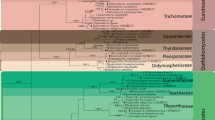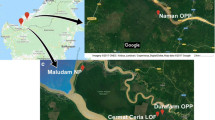Abstract
The mangrove ecosystem plays a crucial role in preserving the biodiversity of plants, animals, and microorganisms that are essential for materials cycles. However, the exploration of endophytic fungi isolated from mangroves, particulary in Santa Catarina (SC, Brazil), remains limited. Therefore, the purpose of this study was to assess the biodiversity of endophytic fungi found in Avicennia schaueriana, Laguncularia racemosa, Rhizophora mangle, and Spartina alterniflora from two mangroves on the Island of Santa Catarina: one impacted by anthropic action (Itacorubi mangrove) and the other environmentally preserved (Ratones mangrove). Samplings were carried out between January 2020 and May 2021. Fungi were isolated from leaves, stems, and roots, identified, and clustered into groups through morphological characteristics. Further, a representative strain of each group was identified through ITS1 sequencing. A total of 373 isolates were obtained from plant tissues, of which 96 and 277 isolates were obtained from Itacorubi and Ratones mangroves, respectively. Molecular identification showed that the endophytic fungal community comprised at least 19 genera. The data on fungal community diversity revealed comparable diversity indices for genera in both mangroves. However, we observed differences in the total frequency of fungal genera between impacted (27.38%) and non-impacted (72.62%) mangroves. These findings suggest that anthropic activities in and around the Santa Catarina mangroves have had negative impact on the frequency of endophytic fungi. This emphasizes the reinforcing the significance of preserving these environments to ensure the maintenance of fungal community diversity.
Graphical abstract



Similar content being viewed by others
Data Availability
All data supporting the findings of this study are available within the article and in the Supplementary Information. All DNA sequences are deposited in the NCBI database (www.ncbi.nlm.nih.gov)
Abbreviations
- PDA:
-
Potato dextrose agar
- SA:
-
Sabouraud agar
- Ffe:
-
Fungal frequency data
- Ni:
-
Number of isolates of genus
- N:
-
Sum of all isolated genera
- AbT:
-
Total abundance
- Ab:
-
Partial abundance
- H:
-
Shannon index
- NT:
-
Total number of isolates of each fungal genera
- NiI:
-
Number of isolates of each genus from the Itacorubi mangrove
- NiR:
-
Number of isolates of each genus from the Ratones mangrove
- FpI:
-
Partial frequency of fungal genera from Itacorubi mangrove
- FpR:
-
Partial frequency of fungi genera from Ratones mangrove
- FT:
-
Total frequency of each genus
References
Abdel-Azeem AM, Salem FM, Abdel-Azeem MA, Nafady NA, Mohesien MT, Soliman EA (2016) Biodiversity of the genus Aspergillus in different habitats. In: Gupta VK (ed) New and future developments in microbial biotechnology and bioengineering. Elsevier, Amsterdam, pp 3–28
Rajpar MN, Zakaria M (2014) Mangrove fauna of Asia. In: Faridah-Hanum I, Latiff A, Hakeem KR, Ozturk M (eds) Mangrove ecosystems of Asia: Status, challenges and management strategies. Springer, New York, pp 153–197. https://doi.org/10.1007/978-1-4614-8582-7
Holguin G, Vazquez P, Bashan Y (2001) The role of sediment microorganisms in the productivity, conservation, and rehabilitation of mangrove ecosystems: an overview. Biol Fertil Soils 33:265–278. https://doi.org/10.1007/s003740000319
Li K, Chenn S, Pang X, Cai J, Zhang X, Liu Y (2022) Natural products from mangrove sediments-derived microbes: structural diversity, bioactivities, biosynthesis, and total synthesis. Eur J Med Chem 230:114117. https://doi.org/10.1016/j.ejmech.2022.114117
Thatoi H, Behera BC, Mishra RR, Dutta SK (2013) Biodiversity and biotechnological potential of microorganisms from mangrove ecosystems: a review. Ann Microbiol 63:1–19. https://doi.org/10.1007/s13213-012-0442-7
Palit K, Rath S, Chatterjee S, Das S (2022) Microbial diversity and ecological interactions of microorganisms in the mangrove ecosystem: threats, vulnerability, and adaptations. Environ Sci Pollut Res 29:32467–32512. https://doi.org/10.1007/s11356-022-19048-7
Figueiroa AC, Brasil G, Pellin A, Scherer MEG (2016) Avaliação da efetividade da integração das Unidades de Conservação federais marinho-costeiras de Santa Catarina. Desenvolv Meio Ambiente 38:361–375. https://doi.org/10.5380/dma.v38i0.46974
Chen Q, Zhao Q, Li J, Ren H (2016) Mangrove succession enriches the sediment microbial community in South China. Sci Rep 6:27468. https://doi.org/10.1038/srep27468
Chapla VM, Biasetto CR, Araujo AR (2013) Fungos endofíticos: uma fonte inexplorada e sustentável de novos e bioativos produtos naturais. Rev Virtual Química 5:421–437
Chatterjee A, Abraham J (2020) Mangrove endophytes: a rich source of bioactive substances. In: Patra Jk, Mishra RR, Thatoi H, Biotechnological Utilization of Mangrove Resources. Elsevier, London, 27–47.
Robl D, Delabona PS, Mergel CM, Rojas JD, Costa PS, Pimentel IC, Vicente VA, Pradella JGC, Padilha G (2013) The capability of endophytic fungi for production of hemicellulases and related enzymes. BCM Biotech 13:94. https://doi.org/10.1186/1472-6750-13-94
Patel HK, Makampara RA, Kalaria RK, Joshi MP (2023) Endophytes: a novel tool for sustainable agriculture. In: Shah MP, Deka D (eds) Developments in Applied Microbiology and Biotechnology Endophytic Association: What, Why and How. Elsevier, New Delhi, India, pp 37–54
Costa IPM, Maia LC, Cavalcanti MA (2012) Diversity of leaf endophytic fungi in mangrove plants of northeast Brazil. Braz J Microbiol 43:1165–1173. https://doi.org/10.1590/S1517-83822012000300044
Sebastianes FLS, Romão-Dumaresq AS, Lacava PT, Harakava R, Azevedo JL, Melo IS, Pizzirani-Kleiner AA (2013) Species diversity of culturable endophytic fungi from Brazilian mangrove forests. Curr Genet 59:153–166. https://doi.org/10.1007/s00294-013-0396-8
Maia LKR, Alves DR, Jacinto-Junior SG, Morais SM, Freire FCO, Bordallo PN, Cardoso JE (2022) Identification and characterization of endophytic fungi found in plants from northeast Brazilian mangroves: a review. Res Soc Dev 11:e5111729459. https://doi.org/10.33448/rsd-v11i7.29459
Pinto RADFO (2019) Bioprospecção e caracterização de fungos endofíticos produtores de compostos bioativos isolados de Dalbergia ecastaphyllum L. Taub. Dissertação de Mestrado em Ciências Biológicas. Universidade Federal de Alfenas, pp 101
Dias LRL, Bastos DKL, Lima NS, Silva MRC, Miranda RCM (2017) Bioprospecção de Microorganismos de Interesse Biotecnológico Isolados em Ecossistema de Manguezal. Rev Investig Bioméd 9:24–30. https://doi.org/10.24863/rib.v9i1.84
Shu-Lei J, Zhe C, Guang-Lei L, Zhong H, Zhen-Ming C (2020) Fungi in mangrove ecosystems and their potential applications. Crit Rev Biotechnol 40:852–864. https://doi.org/10.1080/07388551.2020.1789063
Ferreira AC, Lacerda LD (2016) Degradation and conservation of Brazilian mangroves, status and perspectives. Ocean Coast Manag 125:38–46. https://doi.org/10.1016/j.ocecoaman.2016.03.011
Sovernigo MH (2009) Manguezal do Itacorubi (Florianópolis, SC): Uma revisão da disponibilidade de dados ecológicos visando o direcionamento de novos estudos. Oecologia Brasiliensis 13:575–595. https://doi.org/10.4257/oeco.2009.1304.03
Laurenti A, Fechine VY, de Vasconcelos AGC, dos Santos F, Cavalleri M, Reis M, Ayala Filho GGM (2018) UFSC Micro Basin—A Preliminary Study: A Stream to Call It Ours. In: Leal Filho W, Frankenberger F, Iglecias P, Mülfarth R (eds) Towards Green Campus Operations. World Sustainability Series. Springer, Cham, pp 635–652. https://doi.org/10.1007/978-3-319-76885-4_43
Pandolfo C, Braga HJ, da Silva Jr VP, Massignam AM, Pereira ES, Thomé VMR, Valci FV (2002) Atlas climatológico do Estado de Santa Catarina. Epagri. CD-Rom, Florianópolis
Ananda K, Sridhar KR (2002) Diversity of endophytic fungi in the roots of mangrove species on the west coast of India. Can J Microbiol 48:871–878. https://doi.org/10.1139/W02-080
Riddell RW (1950) Permanent stained mycological preparations obtained by slide culture. Mycologia 42:265–270. https://doi.org/10.1080/00275514.1950.12017830
De Hoog GS, Guarro J, Gene J, Ahmed S, Al-Hatmi A, Figueras MJ, Vitale RG (2020) Atlas of Clinical Fungi. 4th edn, vol 1 and 2. Utrecht/Reus. Netherlands, pp 1600
Samson RA, Houbraken J, Thrane U, Frisvad JC, Andersen B (2019) Food and indoor fungi. Westerdijk Fungal Biodiversity Institute, Utrech, p 481p
White TJ, Bruns T, Lee S, Taylor JW (1990) Amplification and direct sequencing of fungal ribosomal RNA genes for phylogenetics. In: Innis MA, Gelfand DH, Sninsky JJ, White TJ (eds) PCR Protocols: A Guide to Methods and Applications. Academic Press Inc, New York, pp 315–322
Senanayake IC, Rathnayaka AR, Marasinghe DS, Calabon MS, Gentekaki E, Lee HB, Hurdeal VG, Pem D, Dissanayake LS, Wijesinghe SN, Bundhun D, Nguyen TT, Goonasekara ID, Abeywickrama PD, Bhunjun CS, Jayawardena RS, Wanasinghe DN, Jeewon R, Bhat DJ, **ang MM (2020) Morphological approaches in studying fungi: collection, examination, isolation, sporulation and preservation. Mycosphere 11:2678–2754. https://doi.org/10.5943/mycosphere/11/1/20
Akinduyite AE, Ariole CN (2018) Bioactive compounds and antibacterial activity of endophytic fungi isolated from Black Mangrove (Avicennia africana) leaves. Niger J Biotechnol 35:35–42. https://doi.org/10.4314/njb.v35i2.5
Nurunnabi TR, Sabrin F, Sharif DI, Nahar L, Sohrab MH, Sarker SD, Rahman SMM, Billah MM (2020) Antimicrobial activity of endophytic fungi isolated from the mangrove plant Sonneratia apetala (Buch.-Ham) from the Sundarbans mangrove forest. Adv Trad Med 20:419–425. https://doi.org/10.1007/s13596-019-00422-9
Zhang L, Niaz SI, Khan D, Wang Z, Zhu Y, Zhou H, Lin Y, Li J, Liu L (2017) Induction of diverse bioactive secondary metabolites from the mangrove endophytic fungus Trichoderma sp. (strain 307) by co-cultivation with Acinetobacter johnsonii (strain B2). Mar Drugs 15:35. https://doi.org/10.3390/md15020035
Hamzah TNT, Lee SY, Hidayat A, Terhem R, Faridah-Hanum I, Mohamed R (2018) Diversity and characterization of endophytic fungi isolated from the tropical mangrove species, Rhizophora mucronata, and identification of potential antagonists against the soil-borne fungus, Fusarium solani. Front Microbiol 9:1707. https://doi.org/10.3389/fmicb.2018.01707
Chaeprasert S, Piapukiew J, Whalley AJS, Sihanonth P (2010) Endophytic fungi from mangrove plant species of Thailand: their antimicrobial and anticancer potentials. Bot Mar 53:555–564. https://doi.org/10.1515/BOT.2010.074
Li H, Li Z, Ruan G, Yu Y, Liu X (2016) Asymmetric reduction of acetophenone into R-(+)-1-phenylethanol by endophytic fungus Neofusicoccum parvum BYEF07 isolated from Illicium verum. Biochem Biophys Res Commun 473:874–878. https://doi.org/10.1016/j.bbrc.2016.03.142
Luo X, Lin X, Tao H, Wang J, Li J, Yang B, Zhou X, Liu Y (2018) Isochromophilones A–F, cytotoxic chloroazaphilones from the marine mangrove endophytic fungus Diaporthe sp. SCSIO 41011. J Nat Prod 81:934–941. https://doi.org/10.1021/acs.jnatprod.7b01053
Moussa M, Ebrahim W, El-Neketi M, Mándi A, Kurtán T, Hartmann R, Lin W, Liu Z, Proksch P (2016) Tetrahydroanthraquinone derivatives from the mangrove-derived endophytic fungus Stemphylium globuliferum. Tetrahedron Lett 57:4074–4078. https://doi.org/10.1016/j.tetlet.2016.07.091
Yu G, Zhou G, Zhu M, Wang W, Zhu T, Gu Q, Li D (2016) Neosartoryadins A and B, fumiquinazoline alkaloids from a mangrove-derived fungus Neosartorya udagawae HDN13-313. Org Lett 18:244–247. https://doi.org/10.1021/acs.orglett.5b02964
Zhou XM, Zheng CJ, Song XP, Han CR, Chen WH, Chen GY (2014) Antibacterial α-pyrone derivatives from a mangrove-derived fungus Stemphylium sp. 33231 from the South China Sea. J Antibiot 67:401–403. https://doi.org/10.1038/ja.2014.6
Acknowledgements
The authors thank the Fundação de Amparo à Pesquisa e Inovação do Estado de Santa Catarina (FAPESC) for financial support (Grant PRONEM N° 05/2019).
Author information
Authors and Affiliations
Contributions
All authors contributed to the study conception and design. Funding acquisition by Mario Steindel and Gislaine Fongaro. Material preparation, data collection and analysis were performed by Rafael Dorighello Cadamuro, Ana Claudia Oliveira de Freitas, and Mario Steindel. Writing of original draft, Isabela Maria Agustini da Silveira Bastos and Diogo Robl. Writing and review editing, data analysis, and discussion were carried out by Mario Steindel, Gislaine Fongaro, Diogo Robl, Izabella Thais da Silva, Helen Treichel, Louis Pergaud Sandjo, and Patricia Hermes Stoco. All authors read and approved the final manuscript.
Corresponding author
Ethics declarations
Competing interests
The authors declare no competing interests.
Additional information
Publisher’s note
Springer Nature remains neutral with regard to jurisdictional claims in published maps and institutional affiliations.
Responsible Editor: Admir Giachini
Supplementary Information
Rights and permissions
Springer Nature or its licensor (e.g. a society or other partner) holds exclusive rights to this article under a publishing agreement with the author(s) or other rightsholder(s); author self-archiving of the accepted manuscript version of this article is solely governed by the terms of such publishing agreement and applicable law.
About this article
Cite this article
da Silveira Bastos, I.M.A., Cadamuro, R.D., de Freitas, A.C.O. et al. Diversity of fungal endophytes from mangrove plants of Santa Catarina Island, Brazil. Braz J Microbiol 55, 1477–1487 (2024). https://doi.org/10.1007/s42770-023-01234-5
Received:
Accepted:
Published:
Issue Date:
DOI: https://doi.org/10.1007/s42770-023-01234-5




